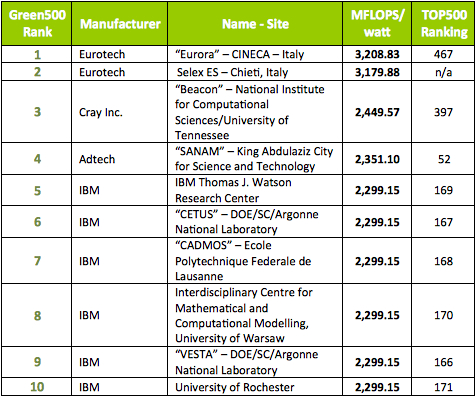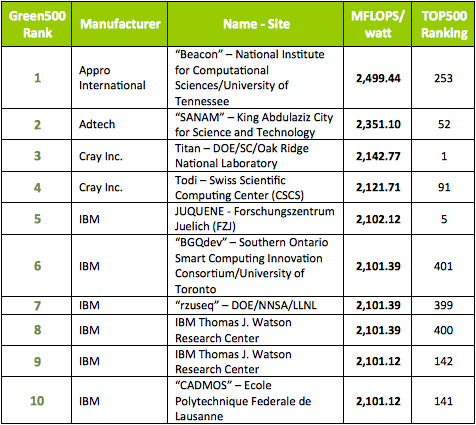Green500: Italian Firm Raises the Stakes with NVIDIA Kepler Parts
The latest Green500 list was published just moments ago, one week after the conclusion of the ISC'13. Launched in November 2007, and now in its seventh year, the Green500 helps raise awareness for sustainable supercomputing by ranking the most powerful systems in the world based on energy-efficiency. Where the TOP500 list is a measure of pure performance, i.e., FLOPS, the Green500 list emphasizes energy-efficiency, using the metric of FLOPS-per-watt.
Onto the Results...
 What a difference a year makes. The apex of the June 2012 list was completely dominated by IBM BlueGenes, and while Big Blue still makes a very good showing this summer, they've ceded precious ground to some heterogenous upstarts. Indeed, the trends that shook up the November 2012 list – an alliance between commodity components and various coprocessor technologies – show no signs of stopping.
What a difference a year makes. The apex of the June 2012 list was completely dominated by IBM BlueGenes, and while Big Blue still makes a very good showing this summer, they've ceded precious ground to some heterogenous upstarts. Indeed, the trends that shook up the November 2012 list – an alliance between commodity components and various coprocessor technologies – show no signs of stopping.
Compared to the November 2012 list, the current version has a lot of familiar elements, but a couple of surprises as well. While the world's attention has been on China's TOP500 king – Tianhe-2 – an Italian systems integrator, Eurotech, was plotting a green coup.
Green500 List Top 10 — June 2013

As we were led to expect, Italy's Eurora supercomputer nabbed the winning spot with a very healthy 3.20 gigaflops/watt. Installed in January at the Cineca facility in Bologna, the Eurotech machine leveraged Kepler GPUs and warm-water cooling to slide right past the previous Green500 champ – the Intel Phi-based Beacon – besting its energy-efficiency (2.44 gigaflops/watt) by an astounding 31 percent.
That Cray Beacon system, installed at the University of Tennessee, dropped to third place – leading us to the surprise newcomer that scored a cool second-place finish with 3.17 gigaflops/watt. Details are still emerging, but we know that it's another Eurotech machine, like Eurora, and it's installed at Selex ES, a major defense electronics company that is also located in Italy. The machine is practically a carbon copy (no pun intended) of its brand-mate at Cineca. They both employ the same Eurotech Aurora Tigon architecture with two Intel Xeon E5-2687W CPUs and two NVIDIA K20 GPU accelerators per node, connected via a 40 Gbps QDR Infiniband backplane. Their minimal differences are expressed in the Selex machine's slightly higher Rmax (98.6 teraflops v 98.5 teraflops) and slightly higher power profile (31.02 kW v 30.7 kW). However, the systems are so alike that they are separated by less than 1 percent difference in energy efficiency.
Number four on the list, down from number two in November is King Abdulaziz City for Science and Technology's SANAM supercomputer, which is the only computer on the list powered by AMD's FirePro GPU. AMD GPUs (Radeons) appear only twice more on the list (#35 and #120). Intel Phi, on the other hand, despite being a relative newcomer, has already made its way into 12 Green500 systems (up from nine on the previous list), including Beacon, as mentioned previously.
Rounding out the rest of the list were the usual suspects, a big presence from IBM and HP, with some Crays, Bulls, SGIs, and a scattering of other system makers. IBM clumping was still very much in effect with rows five through ten and 13 through 28 entirely occupied by the famously efficient BlueGenes. All in all, there were 159 IBM systems, ranging from BlueGenes to iDataplex to xSeries clusters, as well as Power systems, BladeCenter clusters and a few Flex Systems.
HP had an even more significant showing with 187 systems overall, although none were in the top 10, and only one system made it into the top 30 – a Cluster Platform at the University of Southern California which clocked in at 2.24 gigaflops/watt.
In the also-noteworthy category, Titan, which was knocked from its TOP500 perch by China's Tianhe-2, is still a semi-respectable second when it comes to pure LINPACK performance, but in the FLOPS-per-watt race, this DOE darling took a tumble from 3rd place to 29th. As for the Chinese behemoth, it trailed two paces behind at 31, not a bad finish considering its size. Milky-Way 2 – as it's also called – sports 3,120,000 cores and puts out 33.86 petaflops LINPACK (54.9 peak petaflops) – making it nearly twice as powerful as its nearest rival.
JUQUENE, the IBM BlueGene and pride of Germany's Forschungszentrum Juelich dropped from 5th to 14th place, but on the bright side, the overall energy-efficiency of this upgraded system actually increased.
Other than that if you take out the Eurotechs and Beacon – low-core-count machines designed for peak energy-efficiency – the gains are incremental. There is a small performance-per-watt bump in the first bunch of BlueGenes – from 2.10 gigaflops/watt to 2.29 gigaflops/watt. A look at their stats reveals that IBM managed to extract more performance (Rmax) for the same amount of wattage. At least things are moving in the right direction.
Final Thoughts
As with the previous list, the current ranking is still dominated by heterogeneous systems that employ commodity processors hooked into coprocessors. These practices, along with the transition to manycore, tend to pack more performance bang for the energy buck, yet power consumption is still on the rise, a concerning element to the list's founder, Wu Feng. The fact is that current trends won't get us to exascale within a reasonable power envelope, but that's a topic for another article.
Green500 List Top 10 — November 2012

Editors note: the gigaflops per watt decimal places have been corrected.










